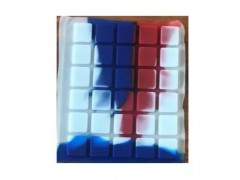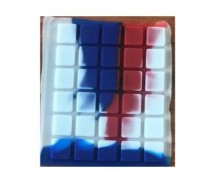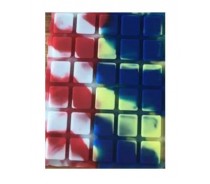|
Product Type:
|
Household Electrical Appliances
|
|
Application:
|
Home Use, Household Appliances, Car, Electronic
|
|
Manufacturing Processes:
|
Pressing Forming Mould
|
|
Cavity:
|
Multi-cavity
|
|
Surface Treatment:
|
Silk Screening
|
|
Working Temperature:
|
(-60℃-200℃)
|
This design guide is intended to offer basic information on keypad design and offer guidelines for you to follow as your project develops.
Silicone rubber keypads are the most widely used form of switching technology today. They offer reliability, long life and design flexibility. If you are currently deciding between various user interface materials, please review some of the benefits that silicone offers.
Silicone Rubber Benefits
Silicone rubber is an excellent material for several reasons;
-
Resistance to both high and low temperatures (-55° C to 250° C)
-
Minimal noise generation due to soft and elastic contact structure
-
Minimal abrasion and high resistance to SO2 and oxidation even in heavy humidity
In addition, silicone rubber offers several features that make its design and usage flexible;
-
Design both tactile and linear feedback
-
Translucent color is excellent for backlighting
-
Cost effective
-
Multi-color designs easily accommodated
-
Water and contamination resistant
It will be helpful to familiarize yourself with the following diagram and the Dictionary of Terms Used prior to reviewing the rest of this design guide.

Dictionary of Terms Used
|
Actuation Force
|
Force required to collapse the membrane/web of a rubber switch.
|
|
Air Channel:
|
Air path(s) on the bottom of rubber keypads and switches that allows for air passage/venting when switch is actuated. Switches must be vented on at least two sides.
|
|
Alignment Hole:
|
Through hole in rubber keypad that is used to position keypad in enclosure, generally used when overall keypad size exceeds 3" in either length or width.
|
|
base:
|
Silicone sheet material that joins all keys/switches on a rubber keypad. Also known as an apron. Typically 1-2mm thick.
|
|
Bezel:
|
The faceplate, typically either plastic or metal, used to secure a keypad to a printed circuit board. The bezel also aligns the keypad during the final assembly and protects keypad base material from contact with human hands.
|
|
Breakdown Voltage:
|
Voltage at which an insulator or dielectric ruptures.
|
|
Compression Set:
|
The measurement of a material's ability to recover its original size and shape after compression under prescribed conditions. It is usually expressed as a recovery percentage (fraction) of the compression condition.
|
|
Conductive Rubber Switch:
|
Mechanical switch made of silicone rubber with either direct or indirect contact.
|
|
Contact:
|
The current carrying area/surface under each rubber key (conductive pill or carbon inked surface) that makes an electrical connection with the electrode on a printed circuit board when the switch is actuated.
|
|
Contact Force:
|
The force required to maintain rubber-switch contact closure.
|
|
Contact Rating:
|
The electric power handling capability for rubber contacts under strictly controlled laboratory conditions.
|
|
Dielectric Strength:
|
(see Breakdown Voltage)
|
|
Durometer:
|
Measurement of the relative hardness of a piece of rubber.
|
|
Dual Durometer:
|
Silicone rubber keypads manufactured using two compression molds or two different material densities.
|
|
Dual Durometer:
|
Silicone rubber keypads manufactured using two compression molds or two different material densities.
|
|
Electrode:
|
Contact surface/design on a printed circuit board that conducts current when rubber switch is actuated and switch closure occurs.
|
|
Key Height:
|
The measured distance from the bottom of a keypad (the base) to the top surface of a key.
|
|
Legend:
|
Printed graphic symbol, letter, or number printed on the top of the key surface.
|
|
Life:
|
Number of actuations before switch membrane ruptures or stresses.
|
|
Membrane:
|
The non-conductive hinge that permits a rubber key to flex and is responsible for the tactile feel realized (also called flexing web or web).
|
|
Negative Image Graphics:
|
Graphics that allow switch color to be seen through top surface printing on keyboard (also called reverse image).
|
|
Overstroke:
|
Additional travel experienced with a rubber switch after initial switch closure has been realized. Rubber switches with overstroke require a double cone or double bell shaped membrane.
|
|
Positive Image Graphics:
|
Single or multi-color printing on top of key surface.
|
|
Return Force:
|
Force created by switch membrane as it returns the key to a non-actuated position.
|
|
Snap Ratio:
|
The difference between the actuation force and the contact force of a switch divided by the actuation force.
|
|
Stroke:
|
Distance from the contact surface on a rubber switch to an electrode pattern on a printed circuit board.
|
Basic Key Considerations
Key design will vary with the functional and aesthetic requirements of the application. It is possible to mold a key in almost any shape and to fit almost any configuration. It is important to remember that the key shape will affect the feel of the key. While a circular shaped standard key will have a consistent feel across the entire surface a half moon shaped key will respond different depending upon wher the key is pressed.
once you have decided upon a key shape and layout; the next item to consider is the method for marking the rubber and creating legends. There are three common methods for marking keypads; printing, laser etching, and plastic key caps.
Printing
Printing is the most common method of marking rubber. The rubber is fixtured to flatten the key top then screen printed. There is no limit to the number of colors available. The arc of the key top determines how far printing must be set back from the edge of the key.
There are currently several options available for improving legend life with printed rubber.
-
Plastic Key Caps - custom molded clear plastic is adhered over the legend or molded into the rubber
-
Oil or Epoxy Coating - coating is deposited on the top surface of the key over printing, available in matte, semi-gloss, or gloss finish
-
Drip Coating - drip coating can be hard or flexible. It adds a glossy layer over the key top. It can not be used on some keys with sharp angles. Hard coatings are subject to cracking if the key has large surface areas.
-
Parylene Coating - offers the highest level of protection for a non-plastic coating. Parylene bonds to the rubber at the molecular level.
Laser Etching
Laser etching is especially well suited for applications wher the keypad is backlit. Etching typically involves three production steps.
-
Translucent rubber (any color) is sprayed with a translucent base coat ink which will be the legend color that is visible to the user.
-
Rubber is sprayed with an opaque top coat ink which will be the overall color of the keypad.
-
The top coat of ink is laser etched away using high speed etchers to reveal the base coat.
Alternatively, you can decide to use a single translucent or opaque rubber ink and laser etch the legends revealing the color of the rubber that is used.
Plastic Key Caps
The longest lasting legend type is custom molded plastic. Plastic legends will not wear out. Many cell phone keypads are designed with plastic keys over rubber.
-
Design Considerations
-
-
Ratio & Tactile Feel
The snap ratio of a keypad determines the tactile feel experienced by the user. The recommended snap ratio for designers to maintain is 40%-60%; if droped below 40% the keys will lose tactile feel but have an increased life. Loss of tactile feel means the user will not receive a 'click' feedback during actuation.
Snap ratio is calculated by taking the [ACTUATION FORCE (F1) - ConTACT FORCE (F2)] / ACTUATION FORCE (F1).
The membrane shape and the size of any rubber key mat can be designed to achieve a variety of actuation forces and tactile responses. Most applications require a positive tactile feel and a long life. With these requirements, an actuation force of 125-150 grams and an accompanying snap ratio of 40%-60% is a good recommendation. Other combinations can be achieved by changing the contact stroke, actuation force, key shape and material hardness. RSP works with customers to achieve the specifications required. Always remember to specify a higher actuation force for wider or taller keys.
Reducing Rocking Action
A common problem with rubber keypad design is the rocking action that can occur when a key is pushed. Rocking action can reduce the life of the keypad, make actuation difficult for the user, and cause other problems. The following suggestions will assist in reducing this problem.
-
Add stabilizing posts on base of key
-
Keep key stroke as near 0.8mm as possible
-
Keep web length to a minimum
-
Keep web angle close to 40°
-
Actuation force of 80-150 grams for keys 10-15 mm high and 150-175 grams for keys 15-25mm high
Return force should also be set at 30-35 grams to ensure that keys do not stick.
-
-
Life
The web design and the durometer of the rubber are the two factors that affect keypad longevity most. The design should reduce stress on the rubber if long life is desired. Using higher durometer silicone, increasing the actuation force, or increasing the stroke will all decrease the keypads life.
Rubber Hardness
Rubber hardness for a keypad can vary between 30 and 70 durometer (Shore A). Typically, most keypads are built between 40 and 60 durometer.
-
-
Key Height
For any design, calculate the minimum key height as follows; Keypad base Thickness + Bezel Thickness + Stroke of Key + 0.5mm.
-
-
The carbon pill is the most common contact because of its long life (>10 million actuations) and low resistance (<100W). The pills are usually circular with diameters ranging from 1.5-10mm and thickness from 0.4-0.6mm. Oval shaped pills are also available in a variety of sizes.
Printed carbon contacts are available in any shape however thickness is typically only 10-20 microns and resistance around 800W.
Dipped carbon contacts offer a compromise with any shape being available and contact resistance of <300W.
-
-
Circuit Board Design
Rubber key mats themselves are very reliable in operation. However, when considering a PCB design, the environment in which the keypads are used must be considered to ensure that the complete switching unit is reliable.
The choice of plating for the board is probably the most critical factor with the cheaper tin/lead solder boards not being recommended.
Gold plating over nickel plating is the preferred choice for board design with a recommended layer of 30-50 microns of gold and 100-200 microns of nickel giving a contact resistance of <100W.
Nickel plating is the next best option and the most commonly used; nickel offers good reliability and is more cost effective than gold over nickel. A plating level >200 microns is recommended for the best overall performance.
When designing shorting pads, always attempt to insert as many shorting paths as possible to increase switch reliability and ensure the pad size is never smaller than the carbon pill by a minimum of 1.25 times.
Flexible Printed Circuit Design
Rubber keypads are typically used with printed circuit boards. However, many rubber keypads are also used with flexible printed circuits. Flexible circuits can be made of polyester or copper.
-
-
Drawings
RSP can estimate most rubber projects with a 2D drawing that shows the number of printed colors and the number of rubber colors that are used. When your design moves to production or if you need to receive more accurate pricing you should try to include the following information if applicable:
|
Overall keypad dimensions
|
base thickness
|
|
Key top outside dimensions
|
Overall key heights
|
|
Contact size
|
Mounting hole details
|
|
Mounting boss details
|
Dimensions (keypad and buttons)
|
|
Keypad/switch colors
|
Stroke/travel
|
|
Actuation force
|
Snap Ratio (optional)
|
|
Electrical specs
|
Material specs
|
|
Graphic color(s)
|
Printing artwork
|
-
Keypad Specifications
-
|
Conductor
|
Insulator
|
|
Material
|
Carbon Pill
|
Silicone
|
|
Durometer (Shore A scale)
|
65 +/-5
|
30-80 +/-
|
|
Tensile Strength (kg/cm2)
|
60
|
65-85
|
|
Tear Strength (kg/cm)
|
15
|
10-15
|
|
Compression set (%)
|
20
|
11-22
|
After 22 hrs at 175° C
Specific gravity at 25° C
|
1.18
|
1.11-1.18
|
-
-
Resistance
|
<200W at 12V dc 30mA
|
|
Insulations Resistance
|
>100W at 250V dc
|
|
Max contact loading
|
21V dc 100mA
|
-
-
|
20-25kv/mm
|
|
Constant
|
26-35 MHz
|
|
Volume Resistance
|
>2 x 1012 (W)
|
![]()









